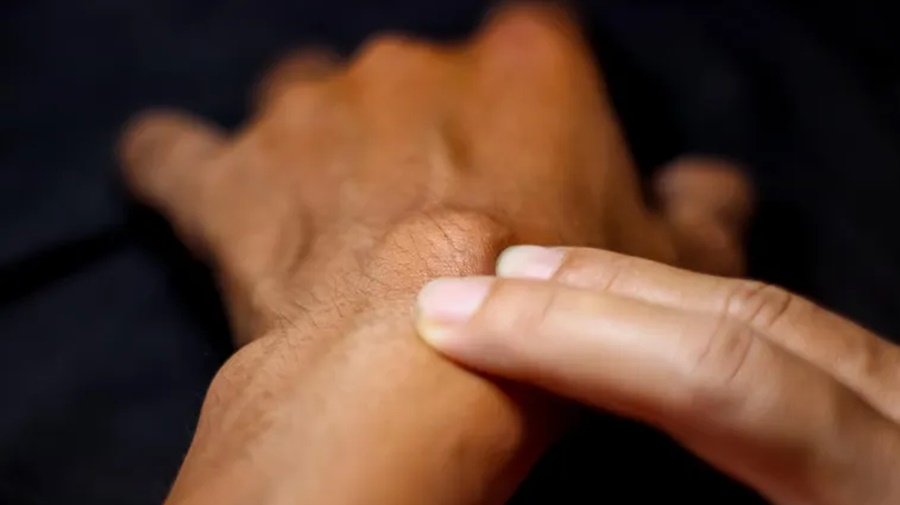
The ganglion is a hard, cherry-sized lump on the joint. However, there is no need to worry: a ganglion is benign and usually goes away on its own. We will tell you which causes and symptoms are typical and when an operation is necessary. / What is ganglion?
The hump-like tumors used to be called “Bible cysts”: They typically appear on the wrist, but can in principle develop on any joint. Because the oldest traditional therapy to get rid of a so-called excess leg consisted of hitting it with a Bible so hard that it burst.
Contrary to what the name ganglion suggests – physicians speak of the ganglion – it is not a bone, but a bulge, inside which fluid collects.
What is ganglion? / How is a joint constructed?
Bones are connected to one another by joints. Around the joint lies the joint capsule, which consists of solid connective tissue. The inside of the joint cavity is filled with a soft layer of connective tissue and a gelatinous fluid (synovial fluid).
Causes: how does a ganglion form?
The ganglion has its origin in a tendon sheath or joint capsule. “It forms when synovial fluid is pressed out of the joint under load,” says Bernhard Rozée from the orthopedic specialist clinics of the Hessing Foundation in Augsburg.
A kind of valve mechanism on the ganglion prevents the fluid from flowing back into the joint and forms a hard cyst. As Rozée explains, the type of stress is not decisive.
What is ganglion: The hands, feet, and fingers are commonly affected
In principle, ganglia can develop at any joint. They are particularly common in areas that are constantly irritated and stressed, such as the hand (at the wrist or finger joints) or the foot (ankle or dorsum of the foot).
Therefore, people who work a lot with their hands, for example on the computer or in manual trades, also have a particularly high risk of getting a sprain.
Protrusion of the soft synovial membrane
Inflammation of the tendon sheath or a capsule rupture also promote the development of a ganglion, since the connective tissue produces more fluid in this case. For this reason, athletes also belong to the risk group.
A genetic predisposition to the formation of the cysts is also suspected. Especially people with weak connective tissue tend to form ganglia. With them, the soft synovial membranes easily turn outwards. The whole thing looks like a swelling or bump.
Sometimes ganglia also appear in older people who have advanced joint wear and tear, i.e. arthrosis. In such cases, it is the osteoarthritis that needs to be treated, not the ganglion. This is particularly common in the finger joints.
What is ganglion: Symptoms of a wrist ganglion
In most cases, a wrist ganglion does not cause pain, it is only an aesthetic problem. Sometimes the nub is so small that it is not even noticed.
Larger ganglia can cause symptoms such as tenderness and restricted movement. If the ganglion also presses on surrounding nerves, it can also lead to tingling and numbness.
Overleg on the hand: what to do?
Kai Megerle, hand surgeon at the Klinikum Rechts der Isar at the Technical University of Munich, strongly advises against the brutal biblical method. “Firstly, there is a risk of injury, and secondly, the ganglion usually comes back very quickly afterwards, since the cause is not eliminated in this way.”
He recommends waiting to see if the bulge causes any discomfort and if it will go away on its own. Because ganglia are completely harmless, rarely cause pain and often disappear just as spontaneously as they came, so that treatment by a doctor is not necessary.
When to the doctor?
However, if the protuberance presses on a nerve or tendon, it can be painful. Sometimes it also interferes with working or writing.
“In such cases you have to do something,” says Rozée. Relieving the joint, for example with a splint, can help temporarily.
Treatment: When is an operation necessary?
If the symptoms persist over a longer period of time and severely affect the life of those affected, doctors recommend surgery for ganglia. An attempt is made to eliminate the valve mechanism of the ganglion and to seal the joint so tightly that no more fluid can escape.
“But before an operation, you should wait at least three months, preferably six months, to see if the ganglion won’t go away on its own,” explains Rozée. Even an operation cannot solve the problem in all cases.
In 10 to 20 percent of those affected, the ganglion comes back afterwards. If you want to have a ganglion removed for aesthetic reasons, you should be aware that a scar will remain after the procedure.
Treatment without surgery: puncture is useless
A gentler method of removing the ganglion is the so-called puncture. You prick the bulge with a needle and suck out the liquid.
“As a rule, the ganglion comes back very quickly afterwards. There is also a risk of infection if germs get into the joint from outside.” Megerle warns: “Infection after a puncture is very rare, but if it happens, there is a risk of permanent pain and restricted mobility.”
Panic attack: Symptoms and treatment
These symptoms indicate pinworms

